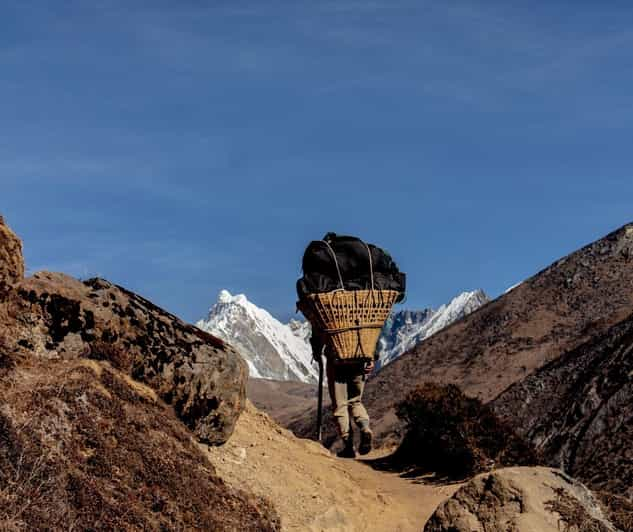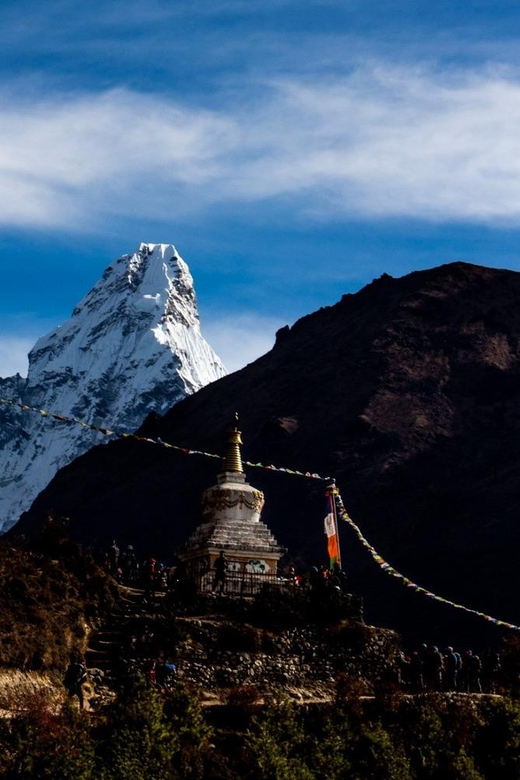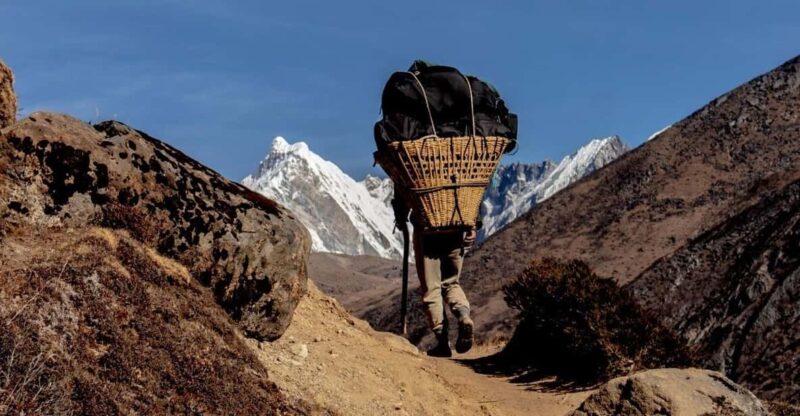The 12-day Everest Base Camp Trek from Kathmandu presents an extraordinary opportunity for adventurers seeking to explore the stunning Himalayan landscape. This trek combines breathtaking views of iconic peaks like Khumbetse and Nuptse with rich cultural experiences in traditional Sherpa villages. With a well-structured itinerary that includes necessary acclimatization stops, trekkers can manage the altitude effectively while enjoying local hospitality. As they prepare for the journey, there are several key factors to consider that could significantly impact their experience. Understanding these elements might just transform their trek into an unforgettable adventure.
Key Points

- The 12-day Everest Base Camp trek begins in Kathmandu and includes a scenic flight to Lukla.
- The trek features acclimatization stops in Namche Bazaar and Dingboche for altitude adaptation.
- Highlights include visiting Tengboche Monastery and experiencing Sherpa culture in local villages.
- The package includes accommodations, meals, transportation, and support from experienced guides and porters.
- Booking is recommended in advance, with a flexible cancellation policy allowing free cancellation up to 24 hours before departure.
Overview of the Trek
The Everest Base Camp trek offers adventurers a thrilling 12-day journey from Kathmandu, showcasing stunning Himalayan landscapes and the vibrant Sherpa culture along the way.
Priced at Kc 34,356 per person, this trek provides an unforgettable experience, highlighting majestic peaks like Khumbetse, Nuptse, and Lhotse.
Participants will trek through picturesque villages, lush forests, and alpine meadows, seeing the rich traditions of the Sherpa people.
Along the route, trekkers visit historic sites, including the Tengboche Monastery, and enjoy breathtaking views from vantage points like Kala Patthar.
With a mix of physical challenge and cultural discovery, this trek is perfect for those seeking adventure and a deeper connection to the Himalayas and its people.
You can also read our reviews of more hiking tours in Pheriche
Detailed Itinerary

Embarking on the Everest Base Camp trek involves a carefully crafted 12-day itinerary that combines breathtaking scenery with cultural experiences and acclimatization strategies.
The adventure kicks off in Kathmandu before flying to Lukla, leading to the charming Phakding. Each day brings new challenges and stunning vistas, from the vibrant Namche Bazaar to the serene Dingboche.
Trekkers spend time acclimatizing in Namche and Dingboche, ensuring they’re prepared for the heights ahead. Highlights include the majestic Tengboche Monastery and the iconic Everest Base Camp.
After soaking in the views from Kala Patthar, trekkers make their way back to Lukla, completing the unforgettable journey. This itinerary balances rigorous trekking with essential rest, making it a rewarding experience.
What’s Included

Trekkers can look forward to a comprehensive package that includes accommodations, meals, transportation, permits, and expert guidance throughout the Everest Base Camp trek.
They’ll enjoy two nights in a comfortable 3-star hotel in Kathmandu, followed by teahouse lodges during the trek. Breakfast in Kathmandu and all meals on the trek are included, ensuring no one goes hungry.
Transportation is seamless, with airport pickups and round-trip flights between Kathmandu and Lukla. Essential permits, like the Sagarmatha National Park entry permit, are also covered.
An experienced English-speaking guide and a porter for every two trekkers offer support. Additional gear such as a down jacket and sleeping bag is provided, along with medical support and 24/7 assistance.
Exclusions to Consider
When planning for the Everest Base Camp trek, it’s crucial to be aware of key exclusions that can impact the overall experience and budget.
First, international airfare to and from Kathmandu and visa fees aren’t included, so trekkers should account for these costs.
Plus, meals in Kathmandu, aside from breakfast, are at the trekker’s expense.
Personal trekking gear and expenses like laundry, calls, or internet access also fall outside the package.
Trekkers should budget for tips for guides, porters, and drivers, along with optional activities.
Lastly, beverages, including alcohol and bottled water, aren’t covered, so it’s wise to set aside funds for hydration during the trek.
Understanding these exclusions ensures a smoother, more enjoyable experience.
More Great Tours NearbyPreparation Tips
To ensure a successful Everest Base Camp trek, proper preparation is essential, including physical training and gathering the right gear ahead of time.
Trekkers should start training at least two to three months prior, focusing on endurance, strength, and cardiovascular fitness. Hiking with a weighted backpack can simulate trek conditions.
Along With physical conditioning, assembling appropriate gear is crucial. Essential items include a good-quality sleeping bag, trekking boots, and weather-resistant clothing. Don’t forget a first-aid kit, trekking poles, and hydration systems.
Lastly, it’s advisable to check weather conditions before departure and stay informed about local customs to enhance the trekking experience.
With the right preparation, trekkers can fully enjoy the adventure that awaits them in the Himalayas.
Acclimatization Strategies
Acclimatizing properly is vital for ensuring a safe and enjoyable Everest Base Camp trek, as it helps the body adjust to the high altitudes encountered along the journey.
Trekkers should follow specific strategies to enhance their acclimatization process:
-
Gradual Ascent: Climb slowly, allowing the body time to adapt to changing altitudes.
-
Hydration: Drink plenty of water to stay hydrated, which assists in reducing altitude sickness symptoms.
-
Rest Days: Incorporate rest days, particularly in Namche Bazaar and Dingboche, to facilitate acclimatization.
Cultural Highlights
Understanding the cultural highlights along the Everest Base Camp trek enriches the journey, offering trekkers a chance to experience the vibrant Sherpa traditions and breathtaking religious sites that define the region.
Trekkers encounter charming villages like Namche Bazaar, where local markets buzz with activity and Sherpa culture thrives. The renowned Tengboche Monastery, perched on a hilltop, provides insight into Buddhist practices and stunning views of the Himalayas.
Along the trail, colorful prayer flags flutter in the wind, symbolizing peace and compassion. Trekkers can also engage with locals, learning about their customs, folklore, and daily life.
This culture enhances the trekking experience, making it not just a physical journey, but a profound exploration of the Sherpa heritage.
Booking Information
Booking the Everest Base Camp trek is a straightforward process, ensuring adventurers can easily secure their spot for this unforgettable journey. Interested trekkers can typically reserve their place online or through local travel agencies in Kathmandu. It’s recommended to book well in advance, especially during peak trekking seasons.
-
Flexible Cancellation Policy: Enjoy peace of mind with free cancellation up to 24 hours before departure for a full refund.
-
Inclusive Packages: Most packages cover accommodation, meals, and necessary permits, simplifying planning.
-
Expert Guidance: Experienced guides and porters enhance the trekking experience, providing valuable insights and support.
Frequently Asked Questions
What Is the Best Time to Trek to Everest Base Camp?
The best time to trek to Everest Base Camp is during spring (March to May) and autumn (September to November). These seasons offer stable weather, clear skies, and pleasant temperatures, ensuring a memorable trekking experience.
How Fit Do I Need to Be for This Trek?
For the trek, a moderate fitness level’s sufficient. It involves long days of walking in varying altitudes. Regular cardio and hiking practice will help; acclimatization days aid in adjusting to high elevations.
Is There Wi-Fi Available During the Trek?
During the trek, Wi-Fi isn’t widely available. Some teahouses might offer limited access, but it’s unreliable. Trekkers should consider offline options for navigation and communication, enjoying the beautiful surroundings without constant connectivity distractions.
Can I Charge My Devices Along the Route?
Along the route, charging devices can be tricky. Most teahouses offer limited charging options, often for a fee. It’s wise for travelers to bring portable chargers to ensure their devices stay powered throughout the trek.
Are There Any Age Restrictions for Participants?
There aren’t strict age restrictions for participants, but trekkers should be physically fit and capable. Typically, ages 12 to 65 are common, and younger children may face limitations due to safety and health concerns.
Recap
To sum it up, the 12-day Everest Base Camp Trek from Kathmandu promises an unforgettable adventure for outdoor enthusiasts.
With stunning scenery, rich Sherpa culture, and expert guidance, trekkers will find themselves immersed in the beauty of the Himalayas.
By adequately preparing and embracing the acclimatization process, participants can fully enjoy this remarkable journey.
Whether you’re a seasoned trekker or a novice adventurer, this trek offers a unique opportunity to experience the majesty of Everest up close.
You can check availability for your dates here:More Hiking & Trekking Tours in Pheriche
More Tour Reviews in Pheriche
Not for you? Here's more nearby things to do in Pheriche we have reviewed
- Everest Base Camp Trek
- Kathmandu: 20 Day Everest Base Camp Trek with Kalapatthar
- Kathmandu : 14 -Day Everest Base Camp with Kala Patthar Trek
- Everest base camp trek 12 days
- Lukla: 11-Day Everest Base Camp Trek from Lukla with Guide
- Nepal: Everest Base Camp with Kalapathar Trek
- From Kathmandu: 12 – Day Everest Base Camp Guided Trek
- Kathmandu: Everest Helicopter Tour with Syangboche Landing
- From Kathmandu: 11- Day Everest Base Camp Trek with Guide
- From Pokhara: 11-Day Budget Everest Base Camp Trek
- Kathmandu : Budget 15-Day Everest Base Camp Trek /2025
- From Lukla: 18-Day Everest Base Camp and Gokyo Lakes Trek
